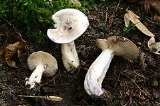
Lactarius uvidus
Encyclopedia
Lactarius uvidus is a European and North American "milk-cap" mushroom, of which the milk turns violet when the flesh is damaged. The fungi generally identified as L. uvidus are part of a complex
of closely related species and varieties which are difficult to delimit definitively, .
It gives its name to the section Uvidi within the genus Lactarius
. It is generally thought to be poisonous (but Moser classifies it as edible with reservations).
as Agaricus uvidus in 1818, before being given its current binomial name by the same author in 1838.
Some less well-known but closely related European species are L. pseudouvidus Kühner (1985) (found in alpine zone, up to 4 cm in diameter, with ochraceous yellow gills), L. robertianus Bon (1985) (also alpine, darker coloured, with smell of cedar wood), and L. luridus (Pers.) Gray (1821) (whose milk goes a deep violet). Since L. uvidus seems to be a cluster of species, it is particularly difficult to pin down the correspondence between descriptions and collections originating from Europe (on one hand) and from North America (on the other).
Some examples of varieties inside the main species are L. uvidus var. pallidus Bres.
(which is whitish), and L. uvidus var. candidulus Neuh. (which is small and pale and comes in muddy places).
Species complex
A species complex is a group of closely related species, where the exact demarcation between species is often unclear or cryptic owing to their recent and usually still incomplete reproductive isolation. Ring species, superspecies and cryptic species complex are example of species complex...
of closely related species and varieties which are difficult to delimit definitively, .
It gives its name to the section Uvidi within the genus Lactarius
Lactarius
Lactarius is a genus of mushroom-producing fungi. The genus, collectively known commonly as milk-caps, are characterized by the fact that they exude a milky fluid if cut or damaged...
. It is generally thought to be poisonous (but Moser classifies it as edible with reservations).
Taxonomy
Lactarius uvidus was first described by Swedish mycologist Elias Magnus FriesElias Magnus Fries
-External links:*, Authors of fungal names, Mushroom, the Journal of Wild Mushrooming.*...
as Agaricus uvidus in 1818, before being given its current binomial name by the same author in 1838.
Description
- The cap of up to about 10 cm is beige or grey and often also has a lilac hue. It is flat-topped or sometimes becomes centrally depressed when older. The surface is greasy or viscous when damp.
- The gillGillA gill is a respiratory organ found in many aquatic organisms that extracts dissolved oxygen from water, afterward excreting carbon dioxide. The gills of some species such as hermit crabs have adapted to allow respiration on land provided they are kept moist...
s are slightly decurrentDecurrentDecurrent is a term used in botany and mycology to describe plant or fungal parts that extend downward.In botany, the term is most often applied to leaf blades that partly wrap or have wings around the stem or petiole and extend down along the stem...
and have a creamy colour, tending to become spotted violet by the milk where damaged. - The milk is initially white and turns violet, but only if left in contact with the gills or flesh. The milk and the flesh taste slightly bitter.
- The pallid stipeStipe (mycology)thumb|150px|right|Diagram of a [[basidiomycete]] stipe with an [[annulus |annulus]] and [[volva |volva]]In mycology a stipe refers to the stem or stalk-like feature supporting the cap of a mushroom. Like all tissues of the mushroom other than the hymenium, the stipe is composed of sterile hyphal...
grows up to about 8 cm high by 2 cm diameter, becoming hollow with age.
Distribution
This cluster of species is found in deciduous and coniferous woods, with a preference towards acid soils. It has a wide distribution in Europe, North Africa, and North America, being fairly common in some regions but rare in others. It appears classified as vulnerable or endangered in the Danish and Dutch Red Lists of Fungi.Related species
Lactarius uvidus belongs to section Uvidi of the genus, the members of which are characterized by milk which discolours violet, and by the greasy cap surface. These mushrooms are divided into two sub-sections: the Aspidieni, which have a whitish, ochre or greyish cap , and the Uvidini (including L. uvidus), which have a lilac, violaceous, or brownish cap. A more complete list of these species can be found in the List of Lactarius species.Some less well-known but closely related European species are L. pseudouvidus Kühner (1985) (found in alpine zone, up to 4 cm in diameter, with ochraceous yellow gills), L. robertianus Bon (1985) (also alpine, darker coloured, with smell of cedar wood), and L. luridus (Pers.) Gray (1821) (whose milk goes a deep violet). Since L. uvidus seems to be a cluster of species, it is particularly difficult to pin down the correspondence between descriptions and collections originating from Europe (on one hand) and from North America (on the other).
Some examples of varieties inside the main species are L. uvidus var. pallidus Bres.
Giacomo Bresadola
Giacomo Bresadola 14 February 1847 – Trento 9 June 1929) was an eminent Italian mycologist. Fungi he named include the deadly Lepiota helveola and Inocybe patouillardii, though the latter is now known as Inocybe erubescens as this latter description predated Bresadola's by a year...
(which is whitish), and L. uvidus var. candidulus Neuh. (which is small and pale and comes in muddy places).

